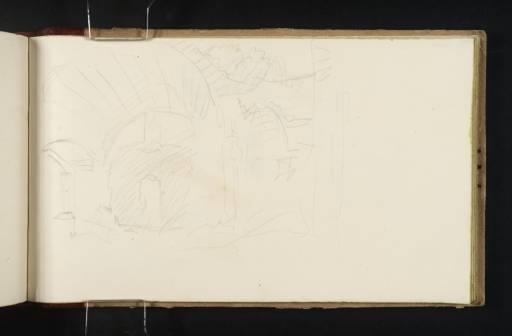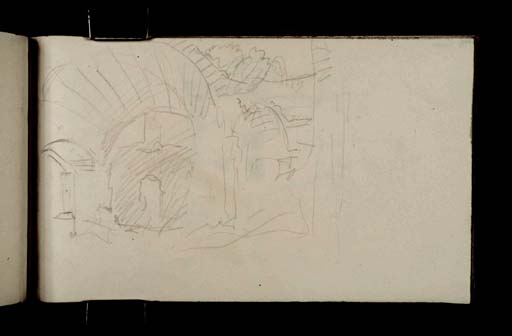Joseph Mallord William Turner Craignethan Castle, Lanarkshire: The Great Hall 1834
Image 1 of 2
Joseph Mallord William Turner,
Craignethan Castle, Lanarkshire: The Great Hall
1834
Joseph Mallord William Turner 1775–1851
Folio 17 Verso:
Craignethan Castle, Lanarkshire: The Great Hall 1834
D26292
Turner Bequest CCLXIX 17a
Turner Bequest CCLXIX 17a
Pencil on off-white wove paper, 113 x 190 mm
Accepted by the nation as part of the Turner Bequest 1856
References
1909
A.J. Finberg, A Complete Inventory of the Drawings of the Turner Bequest, London 1909, vol.II, p.865, CCLXIX 17a, as ‘Ruins.’.
1990
Dr David Wallace-Hadrill and Janet Carolan, ‘Turner’s Sketches North of Stirling’, Turner Studies: His Art and Epoch 1775 – 1851, Vol.10 No.1, Summer 1990, p.12.
David Wallace-Hadrill has identified this sketch as the Great Hall of Craignethan Castle near Crossford in Lanarkshire.1 At the left of the sketch, drawn with the book inverted, we look into a vault towards a narrow doorway with an archway to the left. At the right the roof has collapsed and is open to the sky. Shrubs have taken hold at the top of the wall. This is the western end of the hall with the minstrels’ gallery.
Turner seems to have been determined to record the castle quite thoroughly, sketching its interior and exterior from various different angles (see folio 16 verso; D26290). His interest in this view, however, may have had an additional motivation. The stone vault, partially disintegrated and overtaken by shrubs, may have reminded him of some of the etchings of Roman ruins by Giovanni Battista Piranesi (1720–1778) that inspired some of his early watercolours of church interiors.2 The art historical associations of the scene are likely to have appealed to Turner’s interest and imagination. Piranesi’s perspective may also have prompted the way Turner has slightly skewed the perspective of the scene to fit a wider view into a narrow space. As Wallace-Hadrill noted, the view is ‘to some extent panoramic’.3
Wallace-Hadrill has also suggested another point of interest in this room, noting that it is known as the ‘Queen’s Room’ after Queen Mary lodged there during the battle of Langside, an event which features in Sir Walter Scott’s novel The Abbot (1820). Turner was at this time engaged in collecting material to illustrate a proposed edition of Scot’s Waverley Novels and seems to have been in Lanarkshire to collect views for Old Mortality, 1816,4 including Craignethan which is said by many to have been the inspiration for Tillietudlum Castle, although Scott refuted the claim.5 It is likely that Scott’s publisher, Robert Cadell, explained the significance to one or both of the novels to Turner. Further more, Wallace-Hadrill and Carolan have shown that Turner took an interest in the sites associated with Queen Mary.6
For further information about Turner’s visit to Craignethan Castle, see folio 14 verso (D26286).
Thomas Ardill
October 2010
See David Solkin (ed.), Turner and the Masters, exhibition catalogue, Tate Britain, London 2009, pp.104–5 cats.3 and 4.
See Tour of Scotland for Scott’s Prose Works 1834 Tour Introduction, and Gerald Finley, Landscapes of Memory: Turner as Illustrator to Scott, London 1980, p.179.
‘Craignethan Castle’, Historic Scotland, accessed 6 October 2010, < http://www.historic-scotland.gov.uk/>.
How to cite
Thomas Ardill, ‘Craignethan Castle, Lanarkshire: The Great Hall 1834 by Joseph Mallord William Turner’, catalogue entry, October 2010, in David Blayney Brown (ed.), J.M.W. Turner: Sketchbooks, Drawings and Watercolours, Tate Research Publication, December 2012, https://www


